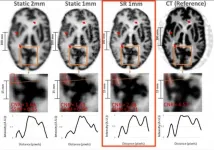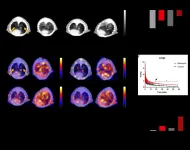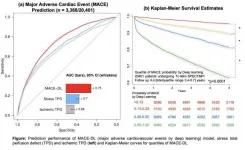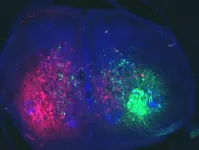Study effects paradigm shift in the understanding of how red rot attacks sugarcane
Researchers at the University of São Paulo discover that the fungus Fusarium verticillioides uses volatile compounds to manipulate insects and plants, promoting its own dissemination
2021-06-14
(Press-News.org) The fungus Fusarium verticillioides is one of the causes of red rot, the most serious sugarcane disease. Losses average around USD 1 billion per harvest in Brazil alone.
The traditional approach to the etiology of this disease is that it is triggered by Diatraea saccharalis, a moth usually referred to as the sugarcane borer. In the caterpillar stage, this insect bores into the stem of the plant, which is later infected opportunistically by the fungus.
However, a study conducted in Brazil by the University of São Paulo's Luiz de Queiroz College of Agriculture (ESALQ-USP) has turned this model upside down, showing that the trigger is not the insect but the fungus. "It's the first scientifically demonstrated case of a pathogenic fungus manipulating both its vector [the insect] and host [the plant] for its own benefit," José Maurício Simões Bento, a professor at ESALQ-USP and one of the principal investigators for the study, told.
An opportunistic fungus does not depend on vectors but infects the host by entering it through a lesion in its structure. This case is different. F. verticillioides changes the characteristics of the vector and host to promote its dissemination. "We establish a new paradigm for the association plant-insect-fungus in sugarcane plantations," Bento said.
The research was supported by São Paulo Research Foundation - FAPESP via grants for two Thematic Projects (Grants 14/50275-9 and 14/50871-0), as well as a PhD scholarship and a master's scholarship awarded to members of the research group.
The group's findings are reported in an article entitled "Fungal phytopathogen modulates plant and insect responses to promote its dissemination", set to publish on June 14 in the prestigious ISME Journal, the official Journal of the International Society for Microbial Ecology, owned by Springer Nature.
"Previously the moth was the target and the idea was that the fungus merely took advantage of holes made in the stem by its caterpillars. We discovered this is not the case. The fungus manipulates the insect in order to penetrate the plant and manipulates the plant to attract more insects," said Márcio de Castro Silva Filho, also a professor at ESALQ-USP and co-principal investigator for the study.
Through several experiments, the researchers discovered that sugarcane plants infected by F. verticillioides produce volatile compounds that are irresistible to pregnant females of the moth Diatraea saccharalis. Attracted by these compounds, the moths lay their eggs in the plants. When the caterpillars hatch, they penetrate the stems and are themselves attracted by the volatile compounds, which they ingest. When they enter the pupal stage and develop into adult moths, they are already carriers of the fungus.
"These infected young moths transmit the fungus to the next generation via their eggs," Silva Filho said. "Unlike healthy moths, they're attracted by the volatile compounds in healthy uninfected plants, which they infect by laying eggs in them. The fungus thereby manipulates both the plant and the insect to promote its dissemination."
Instrumentalized by the volatile compounds, females that do not carry the fungus prefer to lay their eggs in infected plants, while infected females prefer healthy plants. Red rot spreads to more and more cane plantations via this insidious mechanism.
Red rot destroys between 50% and 70% of the sucrose content of infected sugarcane stems. "Our study revolutionizes the science of this disease, considered the most serious threat to sugarcane and responsible for huge losses to ethanol and sugar producers," Silva Filho said. "We show that the caterpillar is the vector, in contrast with the view that the fungus enters the plant via the holes made by the caterpillar."
INFORMATION:
About São Paulo Research Foundation (FAPESP)
The São Paulo Research Foundation (FAPESP) is a public institution with the mission of supporting scientific research in all fields of knowledge by awarding scholarships, fellowships and grants to investigators linked with higher education and research institutions in the State of São Paulo, Brazil. FAPESP is aware that the very best research can only be done by working with the best researchers internationally. Therefore, it has established partnerships with funding agencies, higher education, private companies, and research organizations in other countries known for the quality of their research and has been encouraging scientists funded by its grants to further develop their international collaboration. You can learn more about FAPESP at http://www.fapesp.br/en and visit FAPESP news agency at http://www.agencia.fapesp.br/en to keep updated with the latest scientific breakthroughs FAPESP helps achieve through its many programs, awards and research centers. You may also subscribe to FAPESP news agency at http://agencia.fapesp.br/subscribe.
[Attachments] See images for this press release:

ELSE PRESS RELEASES FROM THIS DATE:
2021-06-14
DALLAS, June 14, 2021 -- Preserving good cardiovascular health during young adulthood is one of the best ways to reduce risks of premature heart attack or stroke, according to new research published today in the American Heart Association's flagship journal Circulation.
The number of premature deaths from cardiovascular disease is increasing in many countries including the U.S. While there is a wealth of information available on maintaining good heart health during and after midlife to reduce the risks of heart attack and stroke, data about cardiovascular health during young adulthood is scarce.
"Most ...
2021-06-14
Nonsteroidal anti-inflammatory drugs (NSAIDs) such as ibuprofen provide better pain control and have fewer adverse effects than codeine, a commonly prescribed opioid, when prescribed after outpatient surgery, according to new research published in CMAJ (Canadian Medical Association Journal) https://www.cmaj.ca/lookup/doi/10.1503/cmaj.201915.
"In all surgery types, subgroups and outcome time points, NSAIDs were equal or superior to codeine for postoperative pain," writes Dr. Matthew Choi, Associate Professor of Surgery, McMaster University, with coauthors.
The researchers conducted a systematic review and meta-analysis of 40 high-quality randomized controlled trials (RCTs) involving more than 5100 adults to compare pain levels and safety of medications containing codeine, such as Tylenol ...
2021-06-14
The raucous calls of tree hyraxes -- small, herbivorous mammals -- reverberate through the night in the forests of West and Central Africa, but their sound differs depending on the location.
Tree hyraxes living between the Volta and Niger rivers make a barking call that is distinct from the shrieking vocalizations of hyraxes inhabiting other regions of the African forest zone.
A new study in the Zoological Journal of the Linnean Society co-authored by Yale anthropologist Eric Sargis finds that the barking hyraxes are a separate species from their shrieking neighbors. The newly described species, Dendrohyrax interfluvialis, ...
2021-06-14
Reston, VA (Embargoed until 5:00 p.m. EDT, Sunday, June 13, 2021) - A new imaging technique has the potential to detect neurological disorders--such as Alzheimer's disease--at their earliest stages, enabling physicians to diagnose and treat patients more quickly. Termed super-resolution, the imaging methodology combines position emission tomography (PET) with an external motion tracking device to create highly detailed images of the brain. This research was presented at the Society of Nuclear Medicine and Molecular Imaging's 2021 Virtual Annual Meeting.
In brain PET imaging, the quality of the images ...
2021-06-12
Reston, VA (Embargoed until 4:30 p.m. EDT, Saturday, June 12, 2021)--Positron emission tomography (PET) using a 68Ga-labeled fibroblast activation protein inhibitor (FAPI) can noninvasively identify and monitor pulmonary fibrosis, according to research presented at the Society of Nuclear Medicine and Molecular Imaging 2021 Annual Meeting. By binding to activated fibroblasts present in affected lungs, FAPI-PET allows for direct imaging of the disease process.
Idiopathic pulmonary fibrosis (IPF) causes substantial scarring to the lungs, making it difficult for ...
2021-06-12
Reston, VA (Embargoed until 6:15 p.m. EDT, Friday, June 11, 2021)--An advanced artificial intelligence technique known as deep learning can predict major adverse cardiac events more accurately than current standard imaging protocols, according to research presented at the Society of Nuclear Medicine and Molecular Imaging 2021 Annual Meeting. Utilizing data from a registry of more than 20,000 patients, researchers developed a novel deep learning network that has the potential to provide patients with an individualized prediction of their annualized risk for adverse events such as heart attack or death.
Deep learning is a subset of artificial intelligence that mimics the workings of the human brain to process ...
2021-06-11
For decades, the ice shelf helping to hold back one of the fastest-moving glaciers in Antarctica has gradually thinned. Analysis of satellite images reveals a more dramatic process in recent years: From 2017 to 2020, large icebergs at the ice shelf's edge broke off, and the glacier sped up.
Since floating ice shelves help to hold back the larger grounded mass of the glacier, the recent speedup due to the weakening edge could shorten the timeline for Pine Island Glacier's eventual collapse into the sea. The study from researchers at the University of Washington and British Antarctic Survey was published June 11 in the open-access journal Science Advances.
"We may not have the luxury of waiting for slow changes on Pine Island; things could actually go much quicker than expected," ...
2021-06-11
PHILADELPHIA - Cells contain machinery that duplicates DNA into a new set that goes into a newly formed cell. That same class of machines, called polymerases, also build RNA messages, which are like notes copied from the central DNA repository of recipes, so they can be read more efficiently into proteins. But polymerases were thought to only work in one direction DNA into DNA or RNA. This prevents RNA messages from being rewritten back into the master recipe book of genomic DNA. Now, Thomas Jefferson University researchers provide the first evidence that RNA segments can be written back into DNA, which potentially challenges the central dogma in biology and could have wide implications ...
2021-06-11
BOSTON - Vitamin D deficiency strongly exaggerates the craving for and effects of opioids, potentially increasing the risk for dependence and addiction, according to a new study led by researchers at Massachusetts General Hospital (MGH). These findings, published in Science Advances, suggest that addressing the common problem of vitamin D deficiency with inexpensive supplements could play a part in combating the ongoing scourge of opioid addiction.
Earlier work by David E. Fisher, MD, PhD, director of the Mass General Cancer Center's Melanoma Program and director of MGH's Cutaneous Biology Research Center (CBRC), laid the foundation for the current study. In 2007, Fisher and his team found something unexpected: Exposure to ultraviolet (UV) rays ...
2021-06-11
For centuries, scientists, aeronautic designers and adventure-seekers have sought to replicate the qualities that allow birds to fly, namely wing-structure and balance. However, without an external mechanism such as a hot air balloon or airplane, humans have remained earth-bound, unable to use their own bodies to propel themselves into the stratosphere.
While researchers have long-focused on structural factors, like wings, that define the category of bird, a recent study published Science Advances by Professor Avihu Klar at the Hebrew University of Jerusalem's Faculty of Medicine and Prof. Claudio Mello from Oregon Health and Science University found that there are specific molecular characteristics that distinguish birds from animals, and these differences allow birds to flap their ...
LAST 30 PRESS RELEASES:
[Press-News.org] Study effects paradigm shift in the understanding of how red rot attacks sugarcane
Researchers at the University of São Paulo discover that the fungus Fusarium verticillioides uses volatile compounds to manipulate insects and plants, promoting its own dissemination




